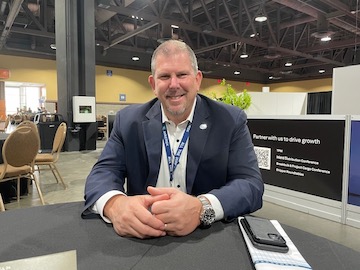Bryan Brandes, Maritime Director, Port of Oakland says the Port is working on a number of projects to improve rail service and upgrade refrigeration capabilities.

Brandes spoke to AJOT at the TPM24 conference taking place in Long Beach, California.
New Rail Connection to Nevada
A new rail connection to Reno, Nevada will soon be operational: “The one that's going to be operational is in Reno … They've already got the facility; they've already got the rail spur. They've already got the agreement with the Union Pacific, which is the hardest thing to do. They are just in the process now of finishing the grading and leveling of the facility so that they can start working a train. … By the summertime we'll have an operating inland rail ramp in Reno and that would allow imports from Oakland to go to Reno. Interstate 80 is a heavily used thoroughfare for trucks, so the Reno rail facility would remove a lot of trucks off that road. It doesn't much help in the middle of the summer, but during the winter, it would help. When the roads close for a day or day or two due to snow, trains keep going through. So, they keep having snowplows to keep pushing through. They do not stop.”
Increasing Refrigeration Capacity
In terms of refrigerated cargoes, the Port has seen expanding reefer plugs on the terminals to be able to handle the refrigerated units while they're on terminals: “The TraPac terminal is in need of additional plugs … 526 additional reefer plugs in addition to their existing 700 … So, a significant increase is coming online in another week. … We were waiting for Pacific Gas & Electric to do final sign off … on increasing the load. And we received approval for that last week. And we just need to do a couple modifications. And within the next couple weeks TraPac should have an additional 526 plugs …
We do have several cold facility …. within the port complex…. Cool Port Oakland being our largest. But we also have PCC Logistics now adding additional reefer transloading and warehouse storage.”
Brandon McDonnell, Chief Operating Officer, PCC Logistics told AJOT:
“Yes. Recently we completed a showroom at one of our older sites about 12,000 square feet in addition to what we currently have. And at our new warehouse, we are in the process of putting in roughly 50,000 square feet of chill room and a small cold storage somewhere around 2000 pallet capacity. In total in Oakland, we'll probably have upwards of 65,000 to 70,000 square feet of showroom and roughly 2,500 pallet positions. We handle upwards of 3000 containers a month in Oakland.
I absolutely agree we need more reefer capacity. I think Oakland's historically an ag export refrigerated port. I think they need to build on that long term reputation. Oakland's always been strong in agricultural exports. A lot of these refrigerated shippers out of the Southeast, South and Midwest have been utilizing Oakland for 35 years. I think we need to ensure the equipment's available, and the steamship line schedules are consistent, and with that, I think we need more cold storage and transloading.”
Turning Basin Oakland Estuary
Brandes said that increasing the capacity for OICT is focused on widening the Turning Basin in the Oakland Estuary: “It’s a significant project to the port, you know, to you know, continue to keep the port able to handle the largest vessels …. to really safely and efficiently move them in and out [of the terminal]. This is a nine year process based on U.S. Army Corps of Engineers rules: three years for feasibility and environmental impact analysis, three years for design and three years for construction.”

